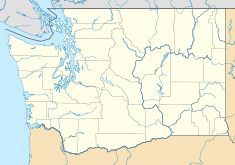- Columbia Generating Station
-
Columbia Nuclear Generating Station Location of Columbia Nuclear Generating Station Country United States Location Benton County, near Richland, Washington Coordinates 46°28′16″N 119°20′2″W / 46.47111°N 119.33389°WCoordinates: 46°28′16″N 119°20′2″W / 46.47111°N 119.33389°W Status Operational Construction began 1973–83 Commission date December 13, 1984 Licence expiration December 20, 2023 Operator(s) Energy Northwest Architect(s) Burns & Roe Reactor information Reactors operational 1 x 1150 MW Reactor type(s) boiling water reactor Reactor supplier(s) General Electric Power station information Generation units Westinghouse Electric Power generation information Annual generation 8,109 GW·h Website
www.energy-northwest.com/generation/cgs/As of 2008-11-15 The Columbia Generating Station, is a nuclear power station located on the United States Department of Energy Hanford Site, 12 miles (20 km) NW of Richland, Washington. Its site covers 1,089 acres (4.4 km²) of Benton County, Washington.
This plant is owned and operated by Energy Northwest, a consortium of Pacific Northwest public utilities. Energy Northwest's original name was the Washington Public Power Supply System (WPPSS). Construction began in late 1975, and the NRC issued an operational license for the plant to begin producing power in March, 1984. [1]
In 2000, WPPSS changed its name to Energy Northwest, and later the plant's name was changed from WNP-2 (Washington Nuclear Power unit number 2) to Columbia Generating Station. Of the five commercial reactors originally planned by WPPSS for the State of Washington, this reactor was the only one completed (WNP-1 may yet be completed but WNP-4, WNP-3 and WNP-5 were abandoned).
The reactor provides Washington with approximately 4% of the state's electrical generation capacity.[2] With the 1992 retirement of Oregon's Trojan Nuclear Power Plant, it is the only commercial nuclear power reactor remaining in the Pacific Northwest. The nearest operating reactor is the Diablo Canyon Power Plant located on the Southern California beach in San Luis Obispo County, California. The plant's sole reactor is a General Electric Type 5, a newer version of the type of reactor used at the Fukushima Daiichi Nuclear Power Plant. The plant had a new Westinghouse Electric turbine-generator installed in 1999, which brought its output rating to 1,150 MWe. [3]
The Columbia Generating Station features six low-profile fan-driven cooling towers. Each tower cascades warmed water, a byproduct of water heat exchanging with steam after leaving a turbine, down itself and subsequently cools the warmed water via a combination of evaporation and heat exchange with the surrounding air. Some water droplets fall back to earth in the process, thereby creating a hoar frost in the winter. At times, the vapor cloud from the cooling towers can reach 10,000 feet (3 km) in height and can be seen at a great distance. Replacement water for the evaporated water is drawn from the nearby Columbia River.
Contents
Surrounding population
The Nuclear Regulatory Commission defines two emergency planning zones around nuclear power plants: a plume exposure pathway zone with a radius of 10 miles (16 km), concerned primarily with exposure to, and inhalation of, airborne radioactive contamination, and an ingestion pathway zone of about 50 miles (80 km), concerned primarily with ingestion of food and liquid contaminated by radioactivity.[4]
The 2010 U.S. population within 10 miles (16 km) of Columbia was 10,055, an increase of 10.4 percent in a decade, according to an analysis of U.S. Census data for msnbc.com. The 2010 U.S. population within 50 miles (80 km) was 445,416, an increase of 23.4 percent since 2000. Cities within 50 miles include Richland (12 miles to city center) and Pasco (18 miles to city center).[5]
Seismic risk
The Nuclear Regulatory Commission's estimate of the risk each year of an earthquake intense enough to cause core damage to the reactor at Columbia was 1 in 47,619, according to an NRC study published in August 2010.[6]
See also
References
- ^ http://www.nukeworker.com/nuke_facilities/North_America/usa/NRC_Facilities/Region_4/wnp/index.shtml
- ^ Washington Department of Community, Trade and Economic Development (2009). "Washington State Electric Utility Fuel Mix". Washington State Department of Commerce. http://www.commerce.wa.gov/DesktopModules/CTEDPublications/CTEDPublicationsView.aspx?tabID=0&ItemID=8954&MId=863&wversion=Staging.
- ^ http://www.energy-northwest.com/generation/cgs/index.php
- ^ http://www.nrc.gov/reading-rm/doc-collections/fact-sheets/emerg-plan-prep-nuc-power-bg.html
- ^ Bill Dedman, Nuclear neighbors: Population rises near US reactors, msnbc.com, April 14, 2011 http://www.msnbc.msn.com/id/42555888/ns/us_news-life/ Accessed May 1, 2011.
- ^ Bill Dedman, "What are the odds? US nuke plants ranked by quake risk," msnbc.com, March 17, 2011 http://www.msnbc.msn.com/id/42103936/ Accessed April 19, 2011.
External links
- "Washington Nuclear Profile". U.S. Department of Energy (DOE). Sept., 2010. http://www.eia.gov/cneaf/nuclear/state_profiles/washington/wa.html. Retrieved 2011-6-1.
- "Columbia Generating Station". Operating Nuclear Power Reactors. U.S. Nuclear Regulatory Commission (NRC). February 14, 2008. http://www.nrc.gov/info-finder/reactor/wash2.html. Retrieved May 05, 2011.
Categories:- Columbia River
- Nuclear power stations in the United States
- Energy resource facilities in Washington (state)
- Nuclear power plants in Washington (state)
- Nuclear power stations using boiling water reactors
- Buildings and structures in Benton County, Washington
Wikimedia Foundation. 2010.

